Violet "Chanson": all about growing a variety
Violet "Chanson" is a selection variety with an original fantasy color. The authorship of the creation of the plant is often attributed to the famous breeder Paul Sorano, but many collectors believe this opinion is erroneous. The variety is not whimsical in content, therefore, it will delight beginner amateur flower growers with its exuberant flowering.
Content:
- Features and reviews of the variety
- Growing conditions
- How to properly care for a violet?
- Soil and container for a flower
- Planting and breeding
- Possible growing problems
Features and reviews of the variety
"Chanson" - unusual terry violet purple with light or dark pink peas on the petals. They have a wavy cut along the edges. Violet flowers are quite large, up to 4-6 centimeters in diameter, they are collected in rosettes of several pieces. The height of the rosettes is standard - 20-22 cm.
The violet leaves are large, slightly rounded, dark green, sometimes even with an olive tint. They have a beautiful glossy surface, they are fleecy on the inside. The cuttings of violets are long, grow up to 10 cm. The violet blooms frequently and profusely, its first flowering cannot always please with its inclusions, only with the development of the rosette they become expressive.
The rosette blooms for about 3 months.
About the violet "Chanson" gardeners leave a lot of positive feedback on the forums. They noted the variety as unpretentious (tolerates errors when watering), prolific (forms many children), neat (the rosette is large, but neat). The violet has extraordinarily beautiful olive-colored leaves and bright purple lace petals with luminous crimson splashes. With proper and uncomplicated care, the Chanson violet will delight you for a long time with its unusual and bright flowering.
Growing conditions
This variety of violets is very sensitive to changes in lighting, so you should not rearrange it from place to place. You need to grow a flower on the southeast or southwest side of the room. In winter, insufficient light can be artificially replenished with a fluorescent lamp. Daylight hours should be at least 10 hours.
Flowers do not tolerate direct sunlight, so it is better not to put them on the south side of the house. If you have to do this, then the windows need to be slightly shaded with curtains, paper or blinds, so the plant will receive diffused light. And if you have to place the violet on the northern windows, then on the contrary, you need to install the backlight, since there it may not have enough light.
In order for the rosettes of the violet to develop evenly, the flower pot is turned to the sunny side by 45 degrees every two to three days.
The temperature regime for growing violets should correspond to 20-25 degrees. In winter, the air temperature should not be below 16 degrees. The plant is equally intolerant of heat and draft. When airing the room, the flower should not be left in a ventilated place; the flower cannot be kept in a completely sealed room either.
The room with violets should be regularly ventilated, the humidity level should not be lower than 50%. It is impossible to spray the plant, this can provoke leaf rot.It is better to humidify the room with the help of adjacent containers of water.
How to properly care for a violet?
Taking care of the Chanson violet variety is not difficult if you adhere to the basic requirements:
- Watering... In the summer, in the heat, you need to constantly maintain the humidity level of the place where the violet grows. The pot can be installed in a container filled with expanded clay with water, only the bottom of the pot should not come into contact with water, otherwise the roots of the flower may rot. It is necessary to water the violet only after the soil has completely dried out, excess moisture is very harmful to the plant, it leads to decay of the roots, leaves and the subsequent death of the entire plant. For watering, soft, melt water or settled for at least a couple of days is suitable. The violet should be watered only at the root; water must not be poured onto the leaves or into the outlet. For the convenience of watering, a watering can with an elongated narrow spout is often used. If water gets on the leaves, it must be carefully removed with a soft paper towel. Violet Chanson should be watered twice a week. In the case of strong pollution of the leaves with dust, the flower can be bathed in a warm shower with a very weak pressure of water, after which it will need to dry out and only then return to its original place.
- Top dressing. If the violet is transplanted twice a year, then it will not need additional feeding. You can feed the flower with phosphorus-potassium fertilizers during the flowering period, but not earlier than two months after the plant is transplanted. With an annual transplant after two months, the flower can be fed, but not more often than once every two weeks. During the formation of the rosette, organic nitrogen-containing fertilizers can be applied, and already during the budding period, nitrogen can be excluded, and potassium and phosphorus can be added instead.
- Transfer. Violet "Chanson" does not like transplants. They transplant it as rarely as possible, on average, once every two years, and then in order to renew the soil. This is done simply by the transshipment method. To do this, you need to tilt (overturn) the flower pot, carefully remove the plant from there, shaking off unnecessary soil from the root and move it to new soil. If necessary, with any disease, overflow or drying of the soil, of course, the violet must be rescued by transplanting. We must not forget that during flowering, the violet cannot be transplanted.
Soil and container for a flower
To transplant violets, you need to prepare the right substrate, it must be nutritious and loose. You can purchase ready-made soil for violets, or you can prepare it yourself by mixing humus, peat, sand and crushed dry foliage. Vermiculite and perlite can be added to the bottom of the pot and covered with soil. Although "Chanson" violets do not like frequent transplanting, if necessary, the flower can be transplanted, only it must be done correctly.
The pot for transplanting should be wide and not very deep, since the violet has a shallow root system.
The diameter of the dishes can be increased when transplanting the plant as the rosette develops; it should be three times less than the diameter of the plant. The optimal size for an adult plant is 10-12 cm.
Planting and breeding
Planting this plant is almost no different from the basic rules for planting varietal violets. You can multiply "Chanson" in several ways:
- With the help of seeds. The seed method is very painstaking and time-consuming; it is used mainly by breeders when breeding new varieties. It should be remembered that self-collected seeds are not suitable for propagation of a hybrid plant variety, since they do not inherit the parental traits.
- Cut a leaf. A stalk rooted in the soil will sprout in one and a half to two months, this is a simple and reliable way to propagate a flower. The leaf stalk can be rooted in water and soil. When rooting in water, the cutting can be transplanted into a pot when the root length is already 0.5 cm. It is impossible to overexpose a leaf in water - it can simply rot.
- Stepsons.Grasshopping is the most effective way to reproduce violets. It is very simple: you just need to separate the stepsons and transplant them into a separate pot. The plant forms a sufficient number of rosettes-stepsons, they are located in the axils of the lower leaves and can be easily removed by biting off with tweezers. Having separated, they are planted in separate seedling cups, pre-filled with a loose substrate. After transplanting, the sprout is covered with a transparent bag, creating a mini greenhouse to retain heat and moisture. After the rosette is completely rooted, the film can be removed. And when the cuttings of the leaves grow up to 4-5 cm, the plant can be transplanted into a pot for further growth. But, this method requires special care, since it is very easy to damage the root or fragile leaves of the plant.
Separated and germinated violets sit in a specially selected pot, in which a drainage layer should be laid 1/4, consisting of fine gravel, pebbles, expanded clay or crushed foam (everything is interchangeable). Then the drainage is sprinkled with the main soil, a sprout or rosette is carefully placed in the center and sprinkled with the remaining substrate. He gently presses his fingers at the base so that with further watering the flower does not bend over. You should know that the transplanted violet is watered only after two days.
Possible growing problems
This variety of violets is prone to the development of many viral, infectious and fungal diseases. And most often plants suffer, weakened by improper care, waterlogged or hypothermic. They are usually amazed powdery mildew, fusarium, late blight, gray rot.
Having found the first signs of a deviation from the norm or the manifestation of the first symptoms of a plant disease, measures should be taken immediately:
- replace the soil with a plant by transplanting it into a new container (disease spores can be found just in the soil)
- remove damaged or rotten leaves
- spray the violet if necessary fungicide (taking into account the characteristics of the disease)
Some novice growers try to feed a sick flower in order to supposedly give it strength. But this cannot be done, weakened by the disease, he is not able to assimilate fertilizer and this will only harm the restoration of the plant. Top dressing should be done only a month after the violet has fully recovered.
In addition to the above diseases, the plant can be affected by spider mites, nematode, aphids, scabbard or mushroom gnats. You can get rid of them by spraying the plant. insecticides, such as, for example, "Aktellik", "Alatar", "Aktara". With proper and uncomplicated care, the Chanson violet will delight you for a long time with its unusual and bright flowering.
More information can be found in the video:



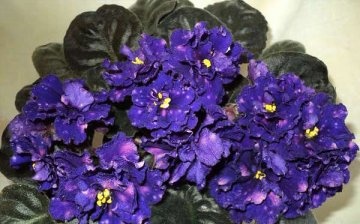
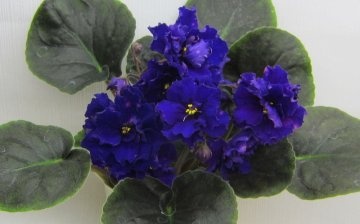

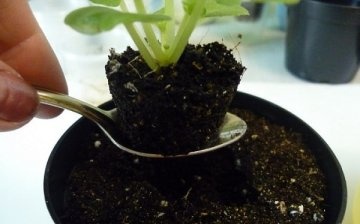
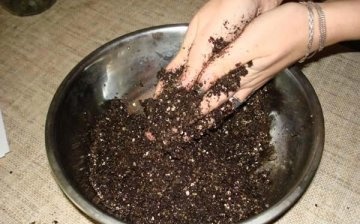
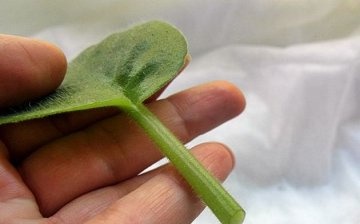
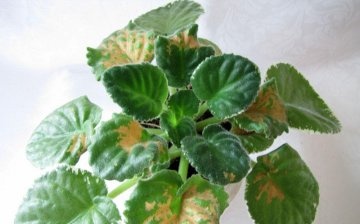







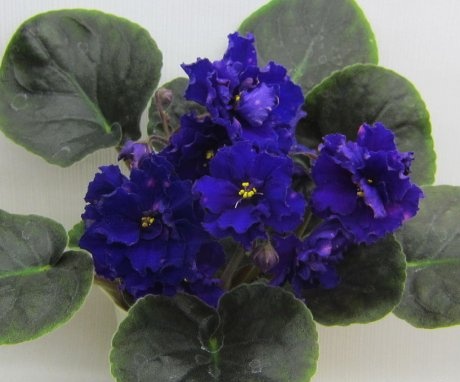
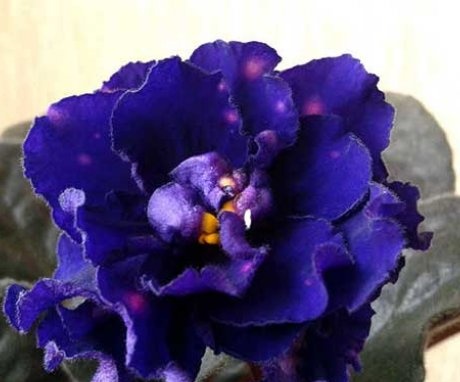
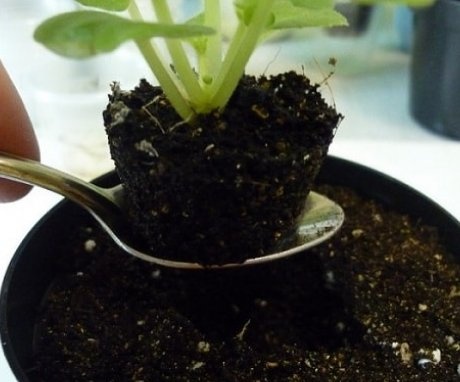

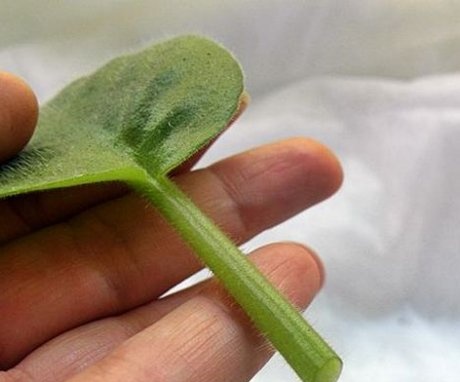
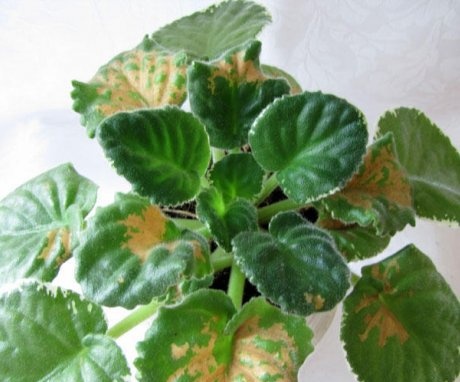
Violet "Chanson" grows in our home and is very unpretentious. It reproduces by a leaf quite easily. Blooms for a long time, almost constantly. Use a small pot.